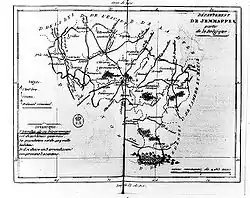Jemmape (department)
Jemmape [ʒɛ.map] was a department of the First French Republic and of the First French Empire in present-day Belgium. It was named after the Battle of Jemappes, fought between the French and the Austrians in 1792 near the village of Jemappes, near Mons. Jemappes was spelled Jemmape, Jemmapes or Jemmappes at the time. Its territory corresponded more or less with that of the Belgian province of Hainaut. It was firstly created on 2 March 1793, and then recreated on 1 October 1795, when the Austrian Netherlands and the Prince-Bishopric of Liège were officially annexed by the French Republic.[2] Before annexation, its territory lay in the County of Hainaut, Tournai and the Tournaisis, the County of Namur (Charleroi) and the Bishopric of Liège (Thuin).
Department of Jemmape | |||||||||||
|---|---|---|---|---|---|---|---|---|---|---|---|
| 1795–1814 | |||||||||||
 | |||||||||||
 Jemmape and other annexed departments | |||||||||||
| Status | Department of the French First Republic and the French First Empire | ||||||||||
| Chef-lieu | Mons 50°27′N 3°53′E | ||||||||||
| Official languages | French | ||||||||||
| Common languages | Dutch | ||||||||||
| Historical era | French Revolutionary Wars | ||||||||||
• Creation | 1 October 1795 | ||||||||||
• Treaty of Paris, disestablished | 30 May 1814 | ||||||||||
| Area | |||||||||||
| 1812[1] | 3,766 km2 (1,454 sq mi) | ||||||||||
| Population | |||||||||||
• 1812[1] | 472,366 | ||||||||||
| |||||||||||
| Today part of | |||||||||||
The Chef-lieu of the department was Mons. The department was subdivided into the following three arrondissements and cantons:
- Mons: Boussu, Chièvres, Dour, Enghien, Lens, Le Roeulx, Mons (2 cantons), Pâturages and Soignies.
- Charleroi: Beaumont, Binche, Charleroi (2 cantons), Chimay, Fontaine-l'Évêque, Gosselies, Merbes-le-Château, Seneffe and Thuin.
- Tournai: Antoing, Ath, Celles, Ellezelles, Frasnes, Lessines, Leuze, Péruwelz, Quevaucamps, Templeuve and Tournai (2 cantons).
After Napoleon was defeated in 1814, the department was dissolved and later it became part of the United Kingdom of the Netherlands as the province of Hainaut.

Administration
Prefects
The Prefect was the highest state representative in the department.
| Term start | Term end | Office holder |
|---|---|---|
| 2 March 1800[3] | 1 February 1805 | Jean-Baptiste Étienne Garnier |
| 1 February 1805[4] | 7 August 1810 | Patrice Charles Gislain De Coninck |
| 7 August 1810[5] | 8 February 1812 | Jean-Baptiste Maximilien Villot de Fréville |
| 8 February 1812[6] | 9 March 1812 | Benoît Joseph Holvoet |
| 9 March 1812[7] | 30 May 1814 | Pierre-Clément de Laussat |
Secretaries-General
The Secretary-General was the deputy to the Prefect.
| Term start | Term end | Office holder |
|---|---|---|
| 2 March 1800 | 30 May 1814 | Robert La Vallée |
Subprefects of Charleroi
| Term start | Term end | Office holder |
|---|---|---|
| 26 April 1800[8] | 30 May 1814 | Stanislas Joseph Troye |
References
- Almanach Impérial. Imprimerie de Sa Majesté. 1812. pp. 415–416.
- Duvergier, Jean-Baptiste (1835). Collection complète des lois, décrets, ordonnances, réglemens et avis du Conseil d'état, t. 8. p. 300.
- Archives Nationales. "GARNIER, Jean-Baptiste Étienne". francearchives.fr. Retrieved 26 June 2019.
- Archives Nationales. "DE CONINCK DIT CONINCK-OUTRIVE, Patrice Charles Gislain". francearchives.fr. Retrieved 26 June 2019.
- Archives Nationales. "VILLOT DE FRÉVILLE, Jean-Baptiste Maximilien". francearchives.fr. Retrieved 26 June 2019.
- Archives Nationales. "HOLVOET, Benoît Joseph". francearchives.fr. Retrieved 26 June 2019.
- Archives Nationales. "DE LAUSSAT, Pierre Clément". francearchives.fr. Retrieved 26 June 2019.
- Tulard, Jean & Marie-José (2014). Napoléon et 40 millions de sujets: La centralisation et le premier empire. p. 308. ISBN 9791021001480.